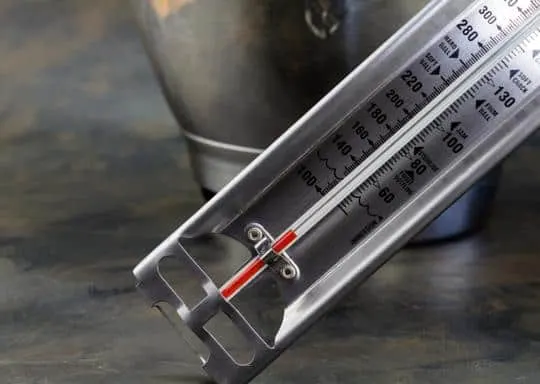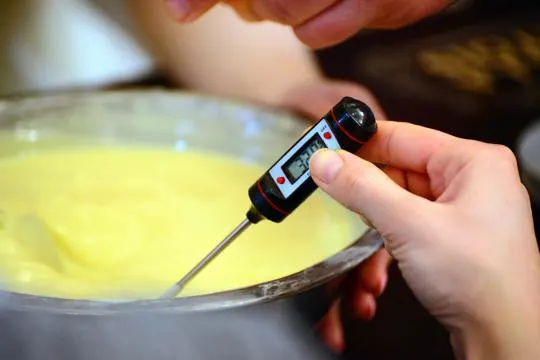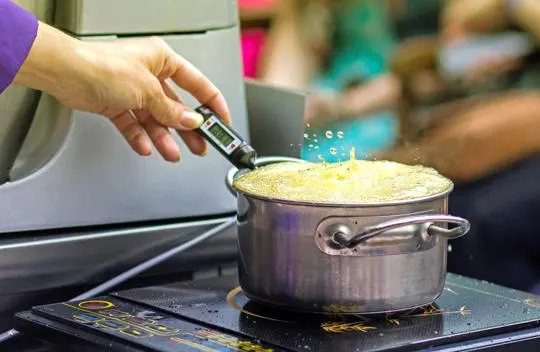Ever tried reading a candy recipe and it casually drops “use a candy thermometer”? We’re like, “Wait, isn’t a thermometer just a thermometer?” Big news: it’s not.
Candy making is an art. And in this art, precision is key. Regular thermometers? They measure fever. Candy thermometers? They measure the exact stage of your sugar concoction. We’ve all been there, squinting at sugar boiling, wondering if we’ve hit the ‘soft ball’ stage.
Without the right tool, it’s a wild guess. Ever ended up with a rock-hard caramel? That was probably a miss in temperature. It’s not just about hitting the right numbers; it’s about the perfect consistency.
Our experiences? Quite the mix of successful fudges and some, well, kitchen disasters. Stick with us. We’re cracking this nut together.
What is a Candy Thermometer?

Candy thermometers are must-haves for confectionery experts and enthusiasts.
These special thermometers measure high temperatures accurately, so users can get perfect results.
Candy thermometers are different than regular thermometers.
They have wider temperature ranges, usually from 100°F to 400°F (38°C to 204°C).
This is important for candy-making, because it needs high temperatures.
Candy thermometers also have a long and thin shape.
This lets them fit in pots or pans safely, without burning one’s hand.
Plus, many candy thermometers come with clips or hooks to attach them to the sides of the pots.
Also, they give accurate readings because of their calibration.
These readings will show important stages in candy making, like soft ball stage or hard crack stage.
This helps cooks monitor their candy and make sure it reaches the desired consistency.
What is a Regular Thermometer?

Regular thermometers are a popular tool for measuring temperature.
They have a glass tube filled with mercury or alcohol, with a scale on it.
The liquid expands or contracts depending on the temperature.
These thermometers are used in various industries and households.
They come in types like oral, rectal, axillary thermometers for body temperature.
Plus, ambient thermometers for air temperature.
Regular thermometers are simple to use and read.
No special training needed.
They offer an easy, accurate way to track temperature changes.
They’re also relatively cheap compared to other thermometers.
Plus, they’re versatile and can be used in many settings, like medical facilities, labs, food industry, and homes.
Regular thermometers have improved over time with things like digital displays and faster response.
This has made them even more accurate and easier to use.
In conclusion, regular thermometers are important tools that give reliable temperature readings.
Whether for measuring our body temperature or ensuring food is cooked properly, these helpful devices remain essential in our lives.
Differences Between Candy Thermometer and Regular Thermometer

A candy thermometer and a regular thermometer may look alike, but they have different uses.
Purpose and Function
A candy thermometer is designed to measure candy temperatures accurately.
It’s specific for the high temps candy-making needs.
Regular thermometers can measure a variety of temperatures, but won’t give as precise results as candy thermometers.
Candy thermometers have long probes, so you can immerse them safely in hot liquids.
They often have markers for soft ball or hard crack stage, so you don’t have to guess when your syrup is ready.
Both types of thermometers can be used for candy-making, but a candy thermometer is better when accuracy and convenience are key.
Invest in a good candy thermometer to get professional results each time you make caramel, fudge, or other treats.
Temperature Range
When it comes to thermometers, a candy thermometer and a regular one are not the same.
The temperature range of a candy thermometer is designed for making candies, caramels, and other sweet treats.
It starts at around 100°F (37.
8°C) and can reach up to 400°F (204.
4°C) or higher in some cases.
This wide range allows for accurate readings when making sugar-based goodies.
A regular thermometer’s temperature range is limited.
It’s used for measuring body temperature or room temperature, and typically starts at 32°F (0°C) and tops out at 212°F (100°C).
This range is ideal for everyday use but may be insufficient for candy-making.
Using a regular thermometer for candy-making can lead to inaccurate readings and potentially ruin your creations.
The specialized design and wider temperature range of a candy thermometer give more precise measurements for successful confectionery endeavors.
In conclusion, candy thermometers and regular thermometers measure temperatures, but their temperature ranges differ.
Candy thermometers are designed for sugar cooking and have a higher temperature range.
Regular thermometers are suitable for everyday use, but may not be ideal for tasks requiring higher temperatures like making candies.
Choose the right thermometer depending on your needs to ensure success.
Accuracy and Precision
Accuracy and precision are key when using thermometers – candy or regular.
These two terms mean how close the measurements are to the true value, and how consistent they are.
Candy thermometers are designed for precise readings of higher temperatures needed for candy making – like the hard crack stage or soft ball stage.
Regular thermometers are usually used for general temperature measurements in cooking or medical settings.
Precision also matters.
Candy thermometers often have more detailed temperature gauges so they can measure more precisely in a specific temperature range related to candy-making.
Regular thermometers have broader temperature ranges but may not give precise readings for candy making.
Plus, candy thermometers come with added features like clips or hooks, so you can attach them easily to pots or saucepans while cooking candy.
This ensures accuracy as the probe is submerged without touching the bottom.
In short, both thermometers have their place when measuring temperature.
But it’s important to understand the differences between candy thermometers and regular thermometers.
Candy thermometers are tailored for higher temperatures, and offer greater precision in smaller ranges.
Regular thermometers are more versatile and work in broader ranges.
Design and Features
Candy thermometers and regular thermometers look similar, but they’re quite different.
Candy thermometers are specially made for making candy.
They have a long probe to measure temperatures without burning your fingers.
Regular thermometers are for lots of industries and settings.
They come in many shapes, sizes, and types.
For example, digital or analog.
Regular thermometers don’t have specific temperatures or uses like candy thermometers.
Candy thermometers measure a large temperature range – up to 400 degrees Fahrenheit (200 degrees Celsius) or more.
This helps cooks get the right temperature when cooking candies like caramel or toffee.
Candy thermometers have special markings.
For instance, “soft ball” or “hard crack”.
These marks show cooks when the mix has reached the right temperature.
Regular thermometers don’t have these markings.
But they can measure different temperatures in scales like Celsius, Fahrenheit, or Kelvin.
Similarities Between Candy Thermometer and Regular Thermometer

A candy thermometer and a regular thermometer are seemingly different, but the two actually share some similarities.
Both measure temperature accurately, and can be used in a variety of situations.
From candy-making to checking body temperature, both thermometers work well.
Functionality-wise, these thermometers have a lot in common.
They each have a long probe that is inserted into the substance or area you wish to measure.
This probe has a sensor that detects temperature changes, showing the results on a display or dial.
This makes it easy to read and understand the temperature.
These thermometers are also versatile.
A candy thermometer is great for cooking sweet treats, but can also be used for other culinary tasks such as deep-frying.
Regular thermometers are commonly found in medical settings, but can also be used to check room temperature or meat doneness.
Despite their similarities, there are some differences.
Candy thermometers are made with materials that can withstand high heat, whereas regular thermometers focus on accuracy when measuring lower temperatures such as body heat.
Applications and Usage Scenarios
Candy thermometers and regular thermometers may look alike, but they serve different purposes.
A regular thermometer measures body temperature, while a candy thermometer is specifically built to measure the heat of sweet liquids such as sugar syrups and chocolate.
Cooking or baking requires the correct thermometer.
Candy thermometers are great for making candies, caramels, jams, and fudges.
They make sure these treats reach the proper temperature during each cooking phase.
This precision is needed for the best texture and consistency.
Regular thermometers are more multipurpose.
In medical settings, they measure body temperature.
In industrial settings, they check temperatures during manufacturing processes or appliances like fridges and ovens.
The design of candy thermometers and regular thermometers also differ.
Candy thermometers usually have a long probe that reaches deeper without touching the bottom.
An adjustable clip or handle lets you attach it to the side of a pot, suspending the bulb in liquid.
To get the best results, it’s important to pick the proper thermometer for the job.
Using a regular thermometer for candy-making may not be accurate.
Conclusion
In conclusion, when in comes to choosing a candy thermometer or regular thermometer, both can be useful tools depending on the situation.
Candy thermometers are great options for more reliably measuring temperatures for soft candies and caramel.
Regular thermometers offer a wider range of accuracy and have multiple uses outside of just making candy.
However, both types of thermometers can occasionally fail to take accurate readings due to their limitations.
To choose the best option for your use-case it’s important to carefully review the available features and make sure you’re aware of the potential limitations you may encounter while using them.
No matter which choice you make, having thorough knowledge about how your equipment works will help ensure that you achieve reliable results every time.

Leave a comment